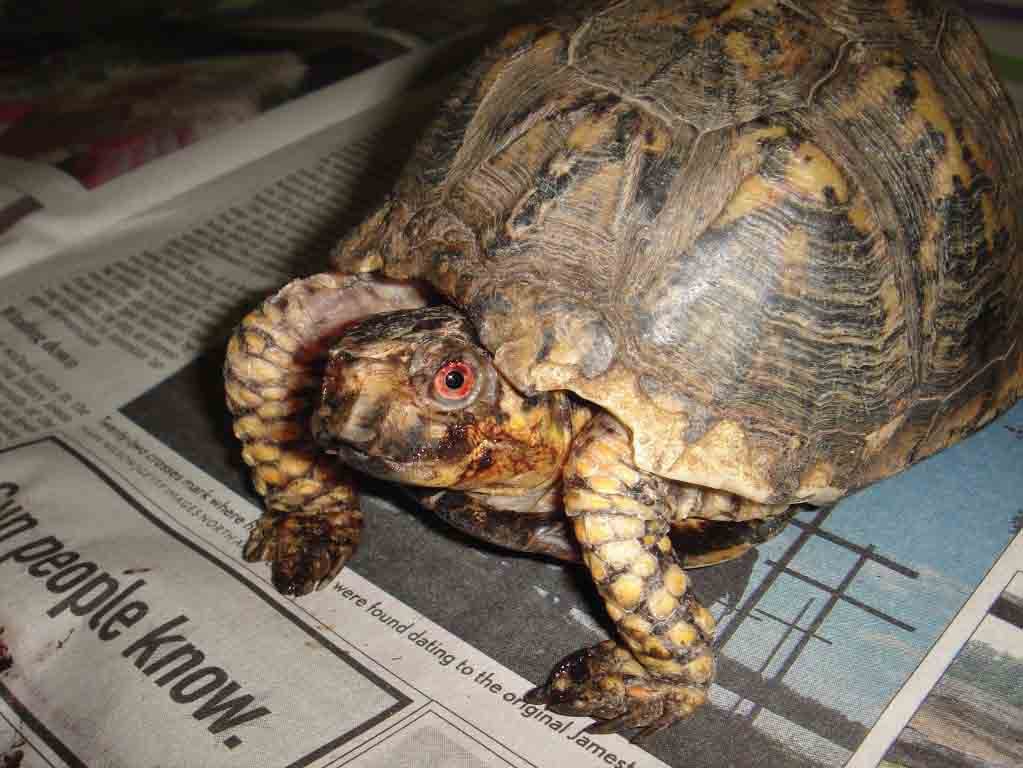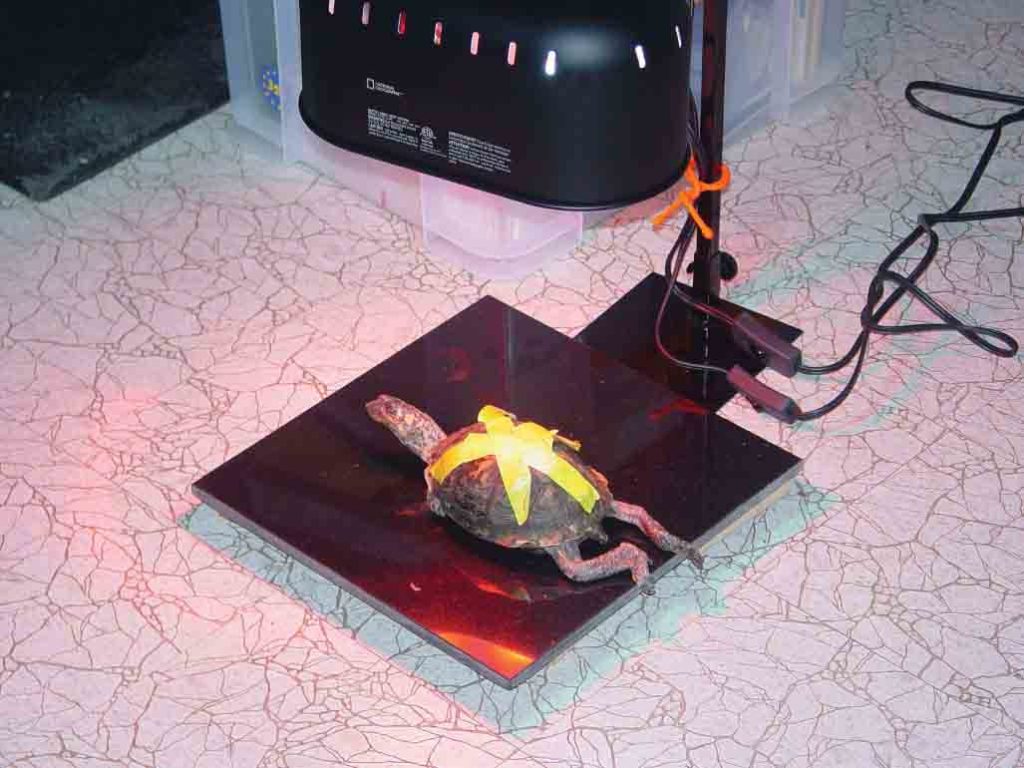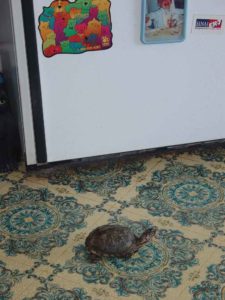
David has a pet eastern box turtle named OT, short for Old Turtle. When David saw OT for the first time, he noticed that the turtle’s nose was bubbling. That meant the turtle was sick! So, David took the turtle to a veterinarian. After medicine, the turtle got healthier, but it was not clear that the turtle would survive if put back in the wild. So, David kept the turtle as a pet.
The Turtle
The veterinarian and David could tell a lot about the turtle from his looks. First, clearly the turtle was an eastern box turtle because of the 6-inch long, dome-shaped shell which was brown with yellow patterns. As usual for an eastern box turtle, the turtle’s skin was brown with yellow spots and the turtle had five toes on the front legs and four toes on the back ones.
The shell indicated that the turtle was old. An eastern box turtle’s shell is made up of a large number of hard plates, called scutes. As the turtle grows, each scute grows bigger. As that happens, growth rings develop on each scute. Counting the growth rings on a scute, gives an estimate of how old a turtle is. When a turtle gets older than about 15 years old, the growth rings merge together so it’s hard to tell exactly how many rings there are. The turtle that David rescued had 30 or more growth rings on his scutes. The veterinarian estimate that the turtle was about 30 or 40 years old which is why David called him OT.
It was also obvious that OT was male because he had orange/red eyes. Female eastern box turtles usually have brown eyes. Another clue that OT was male was that his bottom shell (the plastron) was concave or indented whereas females’ bottom shells are flat.
Chips on OT’s top shell (the carapace) showed that he had been attacked at least once. OT’s shell provides good protection because it is hard, and because its hinge allows it to close like a box — hence their name. Turtles are attacked by skunks, raccoons, and rodents, and clearly, OT’s shell protected him from something.
The Pet
While it is generally not a good idea to make a wild animal a pet, OT thrived under David‘s care. OT has lived with David for about 30 years now. That makes OT about 60 or 70 years old.
Initially, David tried different habitats for OT both indoors and out, but finally settled on having OT live in David’s kitchen/dining room where OT roams free. A board barrier prevents OT from going into other parts of the house. OT hides, frequently in his turtle house. Only when OT wants something, does he come out and sit in the middle of the floor or crawl to David if he happens to be in the room. Sometime in warm weather, David takes OT outdoors to crawl around in the grass. David keeps a close eye on OT when he is outdoors, so he does not get lost or get attacked by a dog or cat.
Over the years, David and OT have developed many routines. When OT is hungry, he goes and sits in front of the refrigerator. He continues to sit there until David gives him food. Box turtles are omnivores, meaning they eat animals and plants for a balanced diet. Also, they need to have an adequate source of calcium for strong shells and bones. OT is a picky eater and his favorite food is worms, which David keeps in the refrigerator. David gives him a variety of other foods such as strawberries, blueberries, tomatoes, and peaches. However, if OT gets a worm first, he will not eat his other food. Usually on alternate days David gives him either a worm or the other foods. If OT wants more food, he goes back and sits in front of the refrigerator. If he is satisfied, he crawls away and hides. Sometimes OT eats as many as six worms in one sitting.
OT enjoys soaking in a shallow pan of warm water a couple times a week. This allows OT to drink and to hydrate his skin. David puts OT in a paint tray in a laundry tub. The paint tray is perfect for OT because he can easily crawl out of the slanted side and the water is not very deep. Sometimes OT stays on the floor by the laundry tub when he is ready for a drink and a soak and other times David just puts OT in the water. OT stays in the water for about a half an hour and usually does his poop. When he is done, OT crawls out of the tray and tries to get out of the laundry tub. When David hears the noise, he knows that OT is ready to get out.

Another activity that OT enjoys a few times a week is basking in a UV light and a heat lamp. David puts OT under the lights on the floor. Then OT stretches out his legs and his neck very long and stays under the lamps as he soaks up the light and heat. He stays there for about a half-hour. When OT has had enough, he just crawls away. Box turtles need ultraviolet light for healthy shells and to properly use vitamins and minerals in their food. They need the heat lamp because they are reptiles. Reptiles are cold-blooded (ectothermic) animals and take on the temperature of their surroundings. In order to warm up, they need to be in a warm place.
Whenever David is sitting in the room, OT frequently crawls over to be near David’s feet. David is always afraid he is going to step on or kick OT. This has led David to put an X made of yellow tape on OT’s shell to make him more visible. Sometimes when OT is under David’s feet, he picks OT up and talks to him nose to nose. OT does not pull his head back into the shell like most box turtles would. He looks at David with great attention. When David is holding OT, he sometimes strokes OT’s head and neck. OT enjoys this very much because he sticks his neck out as far as he can for the stroking. When OT is on the floor or in his turtle house and looking at David, David can motion with his hands for OT to come to him. David does this if he has food for OT. OT comes immediately, but of course at turtle speed.
OT is now a healthy turtle, but every year he needs to go to the veterinarian for a checkup and to get his beak and nails trimmed. Because he is a pet, OT does not have to dig and search for his food and does not wear down his beak or nails. When his beak gets too long, it is hard for OT to eat and needs to be trimmed. This is not an activity that OT enjoys, and he acts more like a snapping turtle than a box turtle during beak trimming. The veterinarian also trims OT’s nails. OT sometimes uses a defense mechanism against the veterinarian and pees on her to avoid the trimming. The snapping and peeing are something that OT has never done to David. But, he readily uses them on the veterinarian.
During the winter, OT brumates from about October to April. Reptiles, like OT, enter brumation which is a period of dormancy like hibernation in mammals. However, brumation is not as deep as hibernation. During brumation, OT stops eating and buries himself in a pile of cloth under the kitchen table. He comes out about once a month during the winter to soak in water and get a drink. At these times he comes out of his cloth cave and sits in the middle of the floor or crawls to David. For a few weeks prior to brumation, OT is very noisy as he clomps around looking for a place to bury himself. The noise is irritating to David who is very glad when OT settles down and starts brumating in his cloth cave.
OT does things that you would not expect from a turtle. OT obviously recognizes David as his friend. David is very attached to OT and committed to his care. Turtles need some care nearly every day and OT could live to be 100 years old or more. Turtle pets cannot just be released into the wild because they would probably not survive. David and OT have developed their close relationship over the years. They seem to understand each other’s habits. This type of pet and human relationship would not be for everyone, but it works well for them.
Carol Bergfeld Mills is a professor emerita of Goucher College in Towson. She can be reached at [email protected].

Let's keep in touch!
Keep up with the latest OutLook by the Bay information by signing up here. We promise not to waste your time.


